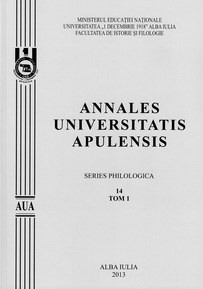The Yellow Decade
The Yellow Decade
Author(s): Petru Ștefan IonescuSubject(s): Literary Texts
Published by: Universitatea »1 Decembrie 1918« Alba Iulia
Keywords: Decadence; Dandyism; Symbolism; Yellow Book; Yellow Nineties
Summary/Abstract: The 1890s are iconic for the development, coronation and fall of Decadence in England. The decade was also named the yellow decade, as yellow was the color chosen by the decadent writers and artists to represent the spirit of those wilde years. The ideas and expressions of the decadents, as well as their manifesto were published by „The Yellow Book” and later „The Savoy”. The self-complacent Victorian society needed no artistic imports, especially from France after the French Revolution. Literature and arts were relatively isolated, the only main influence coming from German scholars and philosophers. Liberalism in politics was not followed in social life and art. On the contrary, after the relaxed morals of the Regency Period, there came, together with the even stronger ascension to power of the bourgeoisie middle-class, a new wave of Puritanism. And art in Britain had to serve society, to educate and lead the citizens towards a better, peaceful, prosperous, harmonious and noble life. There were artists and writers who embraced the idea, and others who rejected it. Only the end of the century and of Victorianism brought with it a new relaxation in British society in relation to morals. The signs of decline were beginning to show now, after the very confident mid-Victorianism made place for the worries of England losing its hegemony both economically and politically to younger nations like America and Germany. A general wave of pessimism started to replace the unlimited optimism of the earlier years. The way was prepared for the generation of the 1890s with its shocking attempts to reform, morally and aesthetically, the conservative British society. Next to Oscar Wilde, Audrey Beardsley or Arthur Symons, widely known as a spokesman of the Decadent Movement, there were other English writers and artists who were influenced by the cultural phenomenon of the decadence: poets like Lionel Johnson, Richard Le Galliene, Ernest Dowson, Michael Field, John Gray, George Moore with his 1870 attempt to imitate Baudelaire Flowers of Passion, Max Beerbohm, or the American-born painter Whistler. Some of the above mentioned poets were members of the Rhymers’ Club (1890-1895), frequented also by W. B. Yeats who also helped founding it. They couldn’t adapt to the society of their times, couldn’t pass the unfair examination of their sad and destroying lives, and were crushed by them. Remembering them Yeats referred to them as the “Tragic generation”. The tribunes for the aesthetic ideas of this generation were the decadent magazines “The Yellow Book” which appeared from April 1894 – April 1897 and the even shorter-lived “The Savoy” with its last number appeared in December 1896. This also marked the end for English Decadence and it transformation into symbolism. Even Symons changed the name of his work into The Symbolist Movement in Literature (1899).
Journal: Annales Universitatis Apulensis. Series Philologica
- Issue Year: 14/2013
- Issue No: 2
- Page Range: 197-2O2
- Page Count: 6
- Language: English

